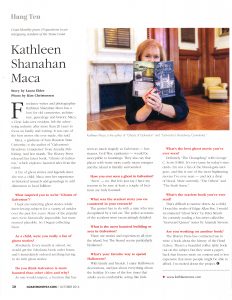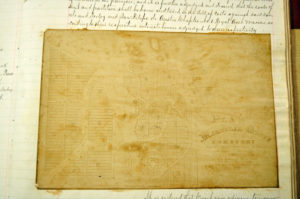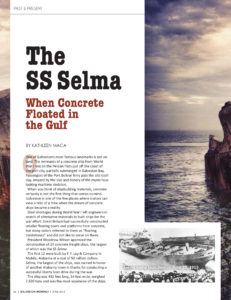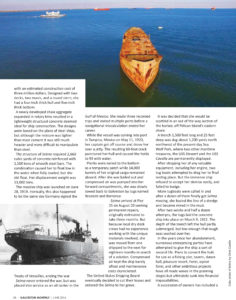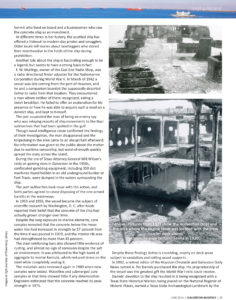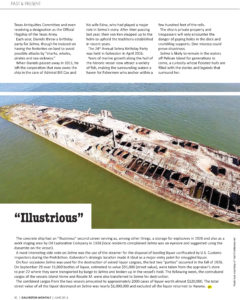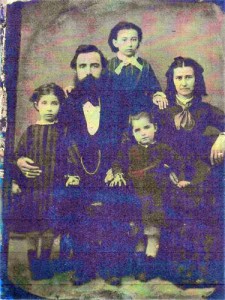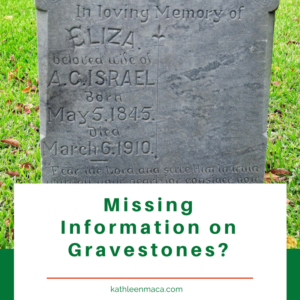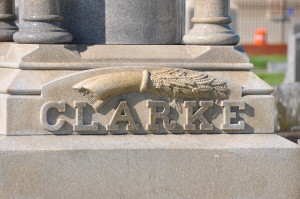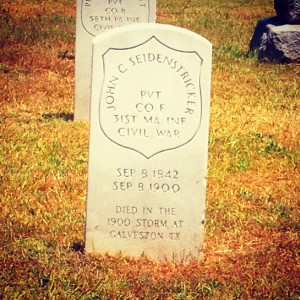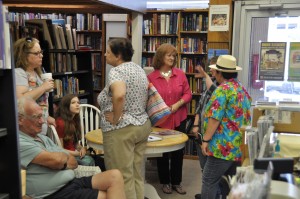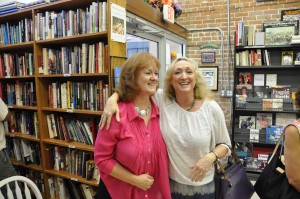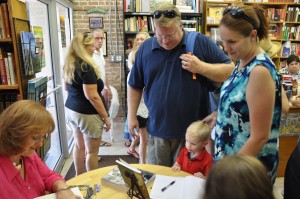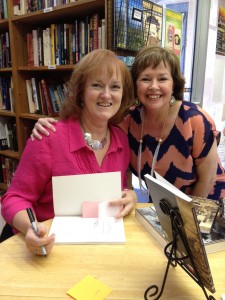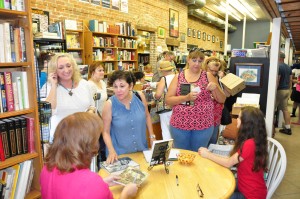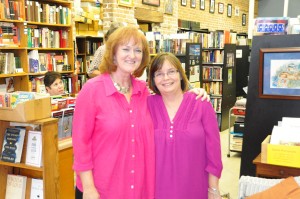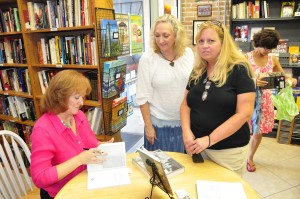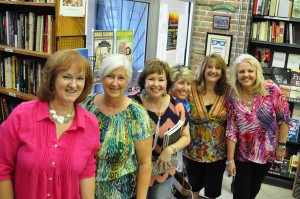Tag: Texas
The Floating Coffin
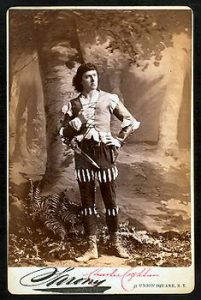 Among the most famous and tantalizing stories to come from the “Ripley’s Believe It or Not” franchise is one that begins with a death at the Tremont House Hotel in Galveston.
Among the most famous and tantalizing stories to come from the “Ripley’s Believe It or Not” franchise is one that begins with a death at the Tremont House Hotel in Galveston.
An Omen
The curious tale began when a young actor named Charles Francis Coghlan visited a gypsy fortuneteller. The mystical soothsayer told Coghlan that he would die at the height of his fame in a southern U. S. city – but that he would have no rest until he returned home.
 The prediction tormented Coghlan, disturbing him so much that he repeated it to friends and co-workers numberous times in the course of his life.
The prediction tormented Coghlan, disturbing him so much that he repeated it to friends and co-workers numberous times in the course of his life.
Over the next thirty years, Coghlan became one of the most famous actors of his day, appearing on stages across the U.S. and Europe. During the rare weeks that he did not appear on the stage, he and his wife retreated to their beloved home on Canada’s Prince Edward Island.
Fate Enters
On October 30, 1899, Coghlan arrived in Galveston with his performing troupe, ready to present one of his own works,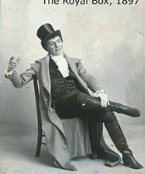 titled “The Royal Box.”
titled “The Royal Box.”
He never had the chance to appear on stage on the island, however. He became seriously ill with what doctors at the time diagnosed as acute gastritis. His understudy, Mr. Robinson, received wonderful reviews often mistakenly credited to Coghlan in print.
The actor’s wife remained with him, transcribing the first four acts of a new play, which he dictated while resting for four weeks. But, after an abrupt relapse of pain, he died in bed at the Tremont Hotel on November 27, with his distraught wife by his side. He was 57 years old and at the peak of his career.
His body was taken to the Levy Brothers Funeral Home, while his wife attempted to make arrangements in a strange city far from family and friends.
The griev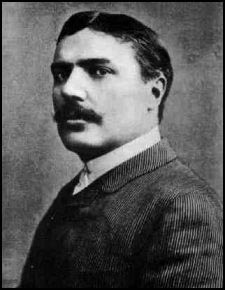 ing widow knew that her husband, upon his death, had wanted to be cremated and buried in New York. Galveston did not have a crematorium at the time, so she arranged for her husband’s body to be sh
ing widow knew that her husband, upon his death, had wanted to be cremated and buried in New York. Galveston did not have a crematorium at the time, so she arranged for her husband’s body to be sh
ipped to the nearest facility in St. Louis.
By the time those preparations were made, a flood of demands from family and admirers insisted he be taken immediately to New York. It is no wonder that confusion exists about the final arrangements for the disposition of the actor’s body. Unfortunately, the funeral home records from this time were destroyed in 1979.
Her funds and energy exhausted, Coughlan’s widow had his remains placed in a temporary receiving vault at the Lakeview Cemetery until she could manage to have him sent to New York the following year.
In September of the following year, the infamous 1900 Storm hit Galveston, killing thousands and sweeping coffins out of mausoleums and vaults. Though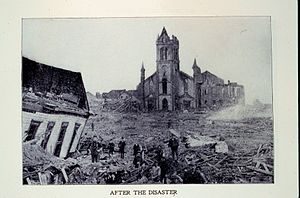 the vault where Coghlan’s body was constructed of heavy granite blocks, it was washed away like so many other structures on the island.
the vault where Coghlan’s body was constructed of heavy granite blocks, it was washed away like so many other structures on the island.
Those coffins that were recovered were reinterred in the cemetery, but many were never found. Coughlan’s casket, which was among the missing, had been caught in the swift-running current and believed to have been swept into the Gulf of Mexico. The New York Actor’s Club offered a sizable reward, but the casket was never located.
Because his widow had purchased an elaborate cast iron casket for her beloved, it is highly unlikely it could do anything but sink in a body of water.
Going Home
In 1929, an edition of “Ripley’s Believe It or Not” published a rumor that had developed in the years after the storm.
The original Ripley feature said: “Charles Coughlan comes home! He died in 1899, and he was buri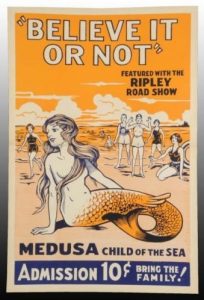 ed in Galveston. When the tragic flood came his coffin was washed out to sea and the Gulf Stream carried his around Florida and up the coast to Prince Edward Island – 2,000 miles distant – where he had lived.”
ed in Galveston. When the tragic flood came his coffin was washed out to sea and the Gulf Stream carried his around Florida and up the coast to Prince Edward Island – 2,000 miles distant – where he had lived.”
Ripley mentioned in October of 1908, fishermen spied a large box floating the Gulf of St. Lawrence. Snagging it with their nets, they pulled the badly damaged object to shore. A silver plate was revealed after cleaning off a few barnacles, which identified it as the casket of Charles Coughlan.
The legend tells that the actor was taken to his home church on Prince Edward Island and buried near the church where he was baptized in 1841. His wandering spirit was finally home.
Truth or Urban Myth?
Numerous books and articles have been written about the incident over the years, with slight to outrageous changes in the details. A brief internet search yields several versions of the story.
Local cemetery records of the small church on Prince Edward are considered to be complete and accurate. They show no sign of Charles Coughlan’s burial, and no gravestone exists.
It was reported that his daughter, actress Gertrude Coughlan Pitou visited Prince Edward in the 1980s and stated that her father’s remains had not been recovered or reinterred in Galveston. This report is seemingly eerie enough, since Gertrude herself died in 1952!
His sister, actress Rose Coughlan, was highly offended by the stories about her brother and she asked Robert Ripley for a retraction. Ripley, ever the savvy businessman, declined. He credited Sir Johnston Forbes Robertson, a Shakespearean actor and friend of Coughlan, for sharing the story with the publication.
The question remains: If Charles Coughlan is not at home at rest, and not in Lakeview Cemetery…where is he?
Magnolia Grove: Galveston’s Lost Victorian Era Cemetery
An article I wrote about the history of Magnolia Grove Cemetery (established 1871) will appear in the September issue of Galveston Monthly Magazine. Now, lost this once elegant, Vi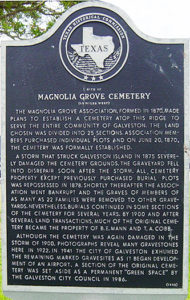 ctorian Era cemetery was the most beautiful burial ground on the island.
ctorian Era cemetery was the most beautiful burial ground on the island.
Not all of the bodies were moved, but the grounds of the cemetery now lie beneath the runways of Scholes Airport and the back nine fairways of the Moody Gardens Golf Course.
My investigation led me to many of the usual resources for history in Galveston, such as the Galveston & Texas History Center (always wonderful), but led me on new research paths as well. No single source seemed to 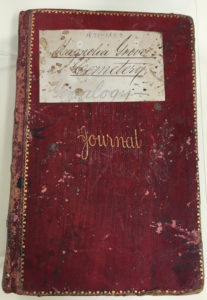 have all of the pieces of information, and many whom I contacted had no knowledge of the lost cemetery at all.
have all of the pieces of information, and many whom I contacted had no knowledge of the lost cemetery at all.
There unfortunately simply wasn’t room to include all of the fascinating information that I found about the lost cemetery, so I will list some of the details here for those who are interested or researching their families.
Magnolia Grove was comprised of 100 acres, divided into 25 sections. They were identified as Sections A through X, and City Circle, otherwise known as Rest of Honor. This circle was reserved for the interment of people of distinguished merit or achievement. The first two burials in this section were the first and last presidents of Texas, David Burnet and Aaron Jones, who were moved from previous burial sites.
Sections 6 and 7 (also known as F & G), which were located on the waterfront, were consecrated by the Catholic Church and reserved for exclusive use of members of that faith.
A portion of Section 2 (B) was purchased by the Masonic lodges and used for burials of Masons and their families. The Tucker fa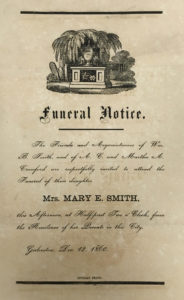 mily, headed by the president of the Magnolia Grove Cemetery Association, was also located in this section.
mily, headed by the president of the Magnolia Grove Cemetery Association, was also located in this section.
Many of the larger lots in the cemetery were purchased by wealthy families and organizations.
Less expensive public lots for white “clients” were located in Section 4, and for “colored” loved ones in Section 5 of the Eastern Division of Magnolia Grove.
The Spanish Benevolent mausoleum still stood after 1900 in Section D on lots 31 and 32, which was part of the southern half of lot 258. Although heavily damaged by weather and vandalized, the mausoleum still stood in the 1920s.
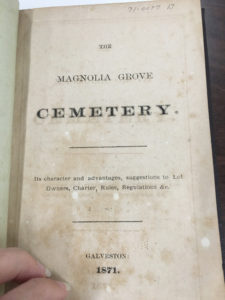 Galveston’s Fireman’s Relief Association purchased a portion of Section B for their members in August 1878.
Galveston’s Fireman’s Relief Association purchased a portion of Section B for their members in August 1878.
Plots in Section J were purchased by Joseph W. Rice and David Guthrie; Section M included family plots for Adriance and Trueheart; Section N for August Kleinecke; and Section P plots belonged to the Sealy, Ball and Hutchings families.
General Wigfall’s plot was in Section Q, and J.P. Davie purchased four lots in Section R.
Section S was home to the The French Benevolent Society lot, as well as the Nahor Biggs Yard and Grover families.
Adolph Flake chose his plot in Section T, but now rests in the Historic Broadway Cemetery District.
John Sidney Thrasher, who married the widow of Galveston’s founder Michel Menard, was buried in the City Circle in 1879.
Of the many illustrious citizens in Galveston who were interred in Magnolia, some remain on the grounds, some were moved to other cemeteries, and some were lost to weather events.
Among the well-known Masons interred at Magnolia Grove who remain there are Henry S. Pearce, First Master of Hope Lodge in another part of the state; Adolph Cycoski, a Civil War veteran and teacher of French in Galveston, also a prominent Mason; and Dr. Benjamin Ball, a prominent businessman who was buried with Masonic ceremonies Feb. 13, 1880.
French native Achilles Mingell; Captain John Price, who formerly owned part of this property, and a residence in the early days; and Isaac McGary, veteran of Texas Revolution,; Mexican American War: and the Battle of San Jacinto are just two of the illustrious people whose graves wer never relocated and are now lost.
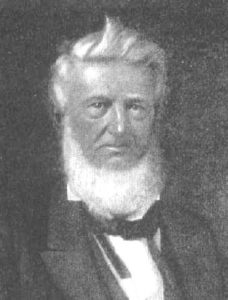 David Burnet (pictured at left) , the first president of Texas, was moved from Magnolia Grove and now rests in the Sherman plot at Lakeview.
David Burnet (pictured at left) , the first president of Texas, was moved from Magnolia Grove and now rests in the Sherman plot at Lakeview.
William Tennant Austin of early Texas revolutionary fame, was mo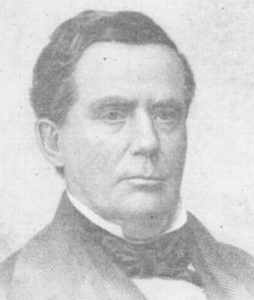 ved from Magnolia to Lakeview Cemetery.
ved from Magnolia to Lakeview Cemetery.
Anson Jones (pictured at right), the last president of Texas, was originally buried in Trinity Episcopal Cemetery, moved to Magnolia Grove Cemetery five miles away in 1871 as part of the opening ceremonies. His remains were moved to Glenwood after 1892.
After the article runs in Galveston Monthly, I will share more information about this fascinating, and sad, loss of history.
SS Selma: Galveston’s Concrete Wonder
Concrete ships? Believe it or not, during World Wr I they became a reality, and Galveston is home to one of the few remnants of the era.
Please allow a few minutes for the pages to download – large files. Or you can read the article online in Galveston Monthly’s June issue at galvestonmonthly.com.
*One correction has come to my attention since this article was published. Raymond Dalehite has kindly let me know that it was his grandfather, Captain Henry Dalehite, who sold the ship and not his father as is stated in the article. I sincerely apologize for this mistake.
Mystery Solved!
 In our last blog visit to the cemetery, we were pondering whether Elizabeth Israel’s husband was ever laid to rest beside her or if he had been interred away from his beloved wife.
In our last blog visit to the cemetery, we were pondering whether Elizabeth Israel’s husband was ever laid to rest beside her or if he had been interred away from his beloved wife.
I am happy to report that I received a reply to my question from a genealogist whose husband is related to the Israel couple.
She shared that they had been told that Alexander died while visiting his sister in St. Louis, but that they had discovered a receipt for his burial next to Elizabeth. The receipt had the payments broken into monthly payments, so it may be assumed that the engraving was too expensive for the family to undertake at the time.
 I am so grateful to know that the couple is together. I don’t know about you, but these situations can make me grieve a bit for those involved, even if they are no relation to me. Yes, people interred in cemeteries are “real” people who led very real lives. I would rather find out about them than read a fictional account of someone who never actually existed.
I am so grateful to know that the couple is together. I don’t know about you, but these situations can make me grieve a bit for those involved, even if they are no relation to me. Yes, people interred in cemeteries are “real” people who led very real lives. I would rather find out about them than read a fictional account of someone who never actually existed.
I’ve added Alexander’s name and information to the Findagrave database for anyone who has the same question in the future.
I was also glad to be able to share a bit of fun information about Alexander with our informant, as well. Although her family knew that he had a registered patent for a washing machine, they had not yet seen a picture of it. Here it is:
 Alexander was quite ingenious, and surely his blacksmithing skills came into play with the design.
Alexander was quite ingenious, and surely his blacksmithing skills came into play with the design.
The description of the machine is in Alexanders own words, so it gives an insight into his engineering skills.
“…the clothes are thoroughly washed or scoured and boiled at the same time. The clothes are thoroughly cleaned without danger of injuring o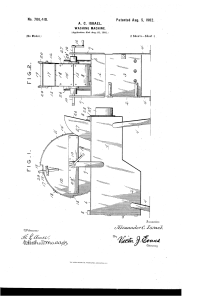 r tearing the same, and the machine is adapted for washing the finest fabrics – lace curtains and the like. The water is kept constantly boiling by the heater and s continuously circulated throughout he revolving drum an brought into contact with the clothes contained therein. The clothes are constantly carried upward and dripped by means of the radially-disposed ribs and are at the same time subjected to the scoring or rubbing action of the rotary washboard.”
r tearing the same, and the machine is adapted for washing the finest fabrics – lace curtains and the like. The water is kept constantly boiling by the heater and s continuously circulated throughout he revolving drum an brought into contact with the clothes contained therein. The clothes are constantly carried upward and dripped by means of the radially-disposed ribs and are at the same time subjected to the scoring or rubbing action of the rotary washboard.”
It actually sounds quite like our washing machines today!
Thanks to Jan for solving our mystery.
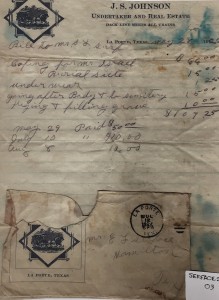 This story has now come full circle, and I got to meet Jan and Eddie in person this week! Eddie even brought me a copy of the undertaker’s bill for Alexander’s funeral. Though the spelling is a bit amusing, once you realize that the funeral cost was quite high for the time it becomes clear that the family probably couldn’t also afford to have his side of the gravestone engraved at the same time.
This story has now come full circle, and I got to meet Jan and Eddie in person this week! Eddie even brought me a copy of the undertaker’s bill for Alexander’s funeral. Though the spelling is a bit amusing, once you realize that the funeral cost was quite high for the time it becomes clear that the family probably couldn’t also afford to have his side of the gravestone engraved at the same time.
Jan and Eddie are looking into having the stone engraving completed.
After having lunch and hearing more about their family genealogy, we went to see the home where Eddie’s family survived Galveston’s 1900 hurricane.
It has been restored, and is adorable! That’s Eddie and his lovely wife Jan standing on the porch.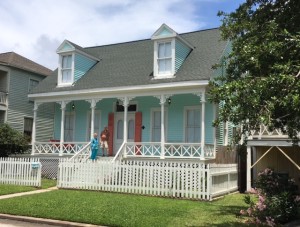
They weren’t able to find out who currently owns the home, but are very interested in finding out. Now the only thing left undone is to hopefully someday see the inside. Hey…it doesn’t hurt to dream!
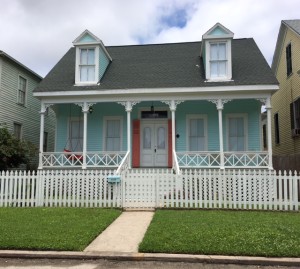
Is Elizabeth Eternally Waiting?
(I’m re-posting this from my former blog “Headstones and Footnotes” because I have some fun updates to share as a follow-up!)
 While walking through the LaPorte Cemetery in Harris County, Texas this gravestone caught my attention. It’s a lovely marker in wonderful shape, despite being over 100 years old. But what intrigued me is that someone seems to be missing.
While walking through the LaPorte Cemetery in Harris County, Texas this gravestone caught my attention. It’s a lovely marker in wonderful shape, despite being over 100 years old. But what intrigued me is that someone seems to be missing.
Only half of the stone is engraved.
“Eliza, beloved wife of A.C. Israel”was interred here in 1910, having passed away at the age of 64. The other side of the marker was obviously left blank in wait for the passing of her husband…but where is he? Unless he is breaking a Guinness World record for age, surely he has passed away by now.
“A.C. Israel” was Alexander Charles Israel, who was born in Ohio in 1844 to native residents of that state. The family also lived in Meigsville, Ohio (1850 census) and St. Louis Missouri (1860).
On September 8, 1864 Alexander married Elizabeth Williams, who was born n 1845 in New York. She was the daughter of Henry Williams (b. 1823) and Harriet (born 1825).
Alexander and Elizabeth lived in Concord, Missouri (1870 census) ad Rock, Missouri (1880) before moving to Texas. They had three daughters together:
Elizabeth “Lizzie” Harriet Israel (Serface) b. 1867-1913
Emma Florence Israel (Serface) b. 1869 – 1954
Cora Belle Israel b. 1871 – 1923
Family photo shows : Alexander Charles and Eliza and their daughters Emma Florence (left), Libby (top) and Cora Belle (bottom).

Elizabeth died in 1910, leaving Alexander a widower.
He was recorded as living in LaPorte, Texas by the 1910 census with his occupation listed as owner of a blacksmith shop. A 38-year-old servant, Lillie Brown, and her six-year-old daughter Helen lived with him. He was still living in Harris County at the time of the 1920 census.
Alexander passed away on May 22, 1922 in Harris County, Texas.
I can find no record of his burial in the LaPorte Cemetery, or in the cemeteries where Elizabeth Harriet (who died just three years after her mother and is interred in Houston) or Emma Florence rest. I have found no grave listing for little Cora.
So the mystery remains…where was Alexander buried. It’s possible that he was laid to rest beside his wife and the engraving was never ordered. It’s sad, but I’ve seen it happen several times.
I have contacted a descendant of the family in an attempt to find Alexander, but haven’t received an answer. Perhaps someone reading this will have a clue.
Until then, his resting place remains a mystery.
Is Eliza still waiting for her beloved husband to join her? “Stay tuned” to find out…
Fashionable New Year’s Visits
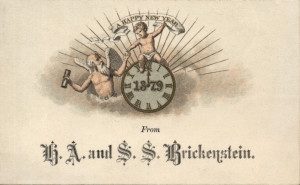
In genteel Victorian-era society, making visits or “calls” was the fashionable thing to do on New Year’s Day.
Gentlemen would don their finest attire and make the rounds, visiting all of the ladies of their acquaintance.
Ladies were discouraged from sending invitations for them to do so, as that would seem “desperate.” Instead, the local papers would often print lists of homes that intended to receive callers that day.
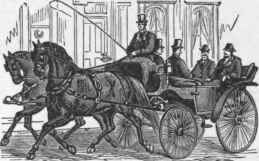
Upon arriving at a home (preferably in a carriage), the gentleman would be invited to remove his hat and overcoat. His gloves were often left on his hands, as the visits, to be considered polite, must be kept fairly brief. – not exceeding then or fifteen minutes.
The gentleman would then send his calling card with a servant to the host, announcing his arrival, and would be ushered into the reception room.
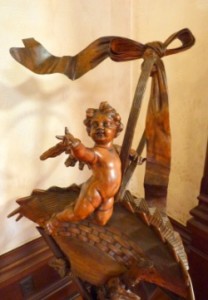 Baskets or receiving trays would hold the cards of each day’s callers. This beautiful example is in the Bishop’s Palace in Galveston.
Baskets or receiving trays would hold the cards of each day’s callers. This beautiful example is in the Bishop’s Palace in Galveston.
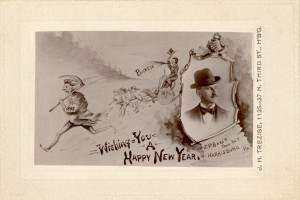
Ladies could receive guests at their own home, or come together in small groups to receive callers together. Young ladies visiting for the holidays partook in the visits of their hostesses’ homes.
They would have spent the previous day making the parlor as inviting as possible with a warm fire, and small table with refreshments such as fruit, cakes, tea and coffee. Alcohol was never served.
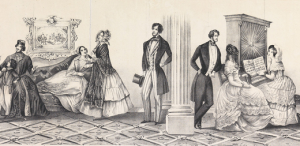 Common visiting hours were from 10 a.m. until 9 p.m. which, although it was enjoyed, must have been quite exhausting. Because of the constant “change of faces” due to the coming-and going of guests, they were to receive each as politely and pleasantly as the first. Thankfully, callers knew to avoid lunch and dinner hours.
Common visiting hours were from 10 a.m. until 9 p.m. which, although it was enjoyed, must have been quite exhausting. Because of the constant “change of faces” due to the coming-and going of guests, they were to receive each as politely and pleasantly as the first. Thankfully, callers knew to avoid lunch and dinner hours.
Calling cards were kept by the hostesses, and often reviewed later. In addition to reminding the hostess of the caller’s name, much could be discerned from the quality and style of the card.
The two or three days succeeding New Year’s were the ladies’ days for calling, “upon which occasion they pass the compliments of the season, comment of the festivities of the holiday, and the number of calls made.”
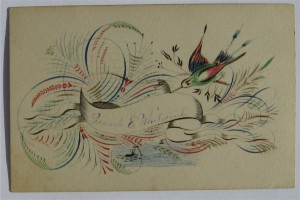 Although the ladies’ visits were considered to be less formal, they would also include refreshments, finery, and by today’s standards seem quite formal.
Although the ladies’ visits were considered to be less formal, they would also include refreshments, finery, and by today’s standards seem quite formal.
Whatever you are doing this New Year’s Day, I hope 2016 brings you laughter, adventure and fun glimpses into our fascinating history!
Bounty of Souls
During the Thanksgivi ng holidays, we are surrounded by symbols of harvest and bounty. One of the most popular symbols of the season’s bounty is a sheaf of wheat, which is why it is often incorporated into decorations.
ng holidays, we are surrounded by symbols of harvest and bounty. One of the most popular symbols of the season’s bounty is a sheaf of wheat, which is why it is often incorporated into decorations.
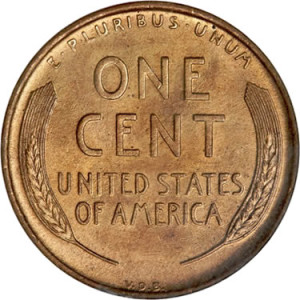 The image is so connected with bounty and prosperity that it was at one time used on United States currency.
The image is so connected with bounty and prosperity that it was at one time used on United States currency.
Religiously, the image of wheat has a deeper meaning. Wheat is baked into the  Eucharist, a motif of everlasting life through belief in Jesus. Therefore when wheat is used on gravestones or memento mori, it represents a divine harvest – being cut to resurrect the “harvest” into everlasting life or immortality.
Eucharist, a motif of everlasting life through belief in Jesus. Therefore when wheat is used on gravestones or memento mori, it represents a divine harvest – being cut to resurrect the “harvest” into everlasting life or immortality.
Wheat has also been symbolic of love and charity in the bible, and was a popular emblem used by Masons.
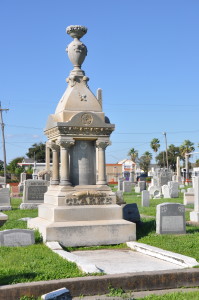 The wheat sheaf can also signify a long and fruitful life, often more than 70 years.
The wheat sheaf can also signify a long and fruitful life, often more than 70 years.
So the net time you see an image of wheat on a grave, check the lifespan of the person who the stone memorializes.
Survived the War – But Not the Storm
Today is the 115th Anniversary of the tragic 1900 hurricane in Galveston, that took thousands of lives. I thought it was only proper for today’s post to pay tribute to a veteran who lost his life in that storm.
Johann “John” Karl “Charles” Seidenstricker was an immigrant who proved his allegiance and dedication to his new country soon after his arrival.
Born on September 7, 1842 in Bad Duerkeim, Pfalz, Bayern, Germany, Johann immigrated to America by himself when he was only 18 years old. He arrived in New Orleans aboard the ship Kate Dyer on February 4, 1861, just two months before the Civil War began.
He served as a private in Company F of the 31st Massachusetts Infantry, while they were stationed in Donaldsonville, Louisiana south of Baton Rouge. In December, joined by companies from nearby Fort Pike, the unit was armed and equipped as cavalry and stationed at Carrollton.
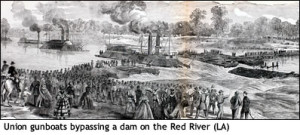 From there, Johann took part in the Red River campaign and was engaged with loss at Sabine Cross Road on April 4, 1864. He re-enlisted during the winter and left on July 21 for furlough in Massachusetts, returning to Donaldsonville in November.
From there, Johann took part in the Red River campaign and was engaged with loss at Sabine Cross Road on April 4, 1864. He re-enlisted during the winter and left on July 21 for furlough in Massachusetts, returning to Donaldsonville in November.
The regiment took part in the operations against Mobile, Alabama and occupied the city after the surrender. Johann remained on duty there until he mustered out on July 31, 1865.
Johann was naturalized in New Orleans on April 30, 1866, no doubt largely in thanks to his service to the country during the war.
 While in New Orleans he met NOLA native Married Elenora Johanna Phillippi (1842-1906). They married on September 10, 1866 at St. Matthew’s Evangelical Church in Carrollton, Louisiana.
While in New Orleans he met NOLA native Married Elenora Johanna Phillippi (1842-1906). They married on September 10, 1866 at St. Matthew’s Evangelical Church in Carrollton, Louisiana.
Johann, now known by his Anglicized name John, and his wife moved to Galveston, and raised a large family, which included Charles Louis “Carl Ludwig” (1868-1925), Elenora Johanna (1869-1962), Emma (1872-1958), Anna Elizabeth (1874-1945), Bertha (1876-1946), Frederick Godfred (1878-1946), Henry William (1881-1952), and Maude Louise (1883-1953).
He became an active member of the community, and was eventually elected a trustee of Knights of Honor’s Goethe Lodge No. 2976, one of two lodges of this fraternal beneficiary society in the city.
From 1888-1891, John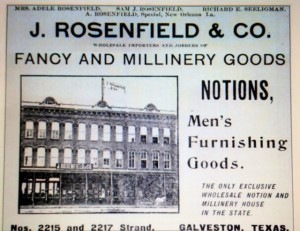 worked as a porter for Rosenfield and Co.
worked as a porter for Rosenfield and Co.
The building where he worked is now part of the historic Strand shopping district, on the second floor above Head to Footsies, The Admiralty and the Rocky Mountain Chocolate Factory.
In 1900, the couple and four of their children (Bertha, Frederick, Henry and Maude) lived together at 1209 Avenue N, very close to what is now Stewart’s Beach.
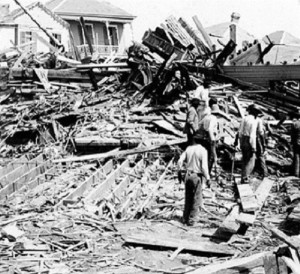 On September 8, 1900 a hurricane which is still the nation’s worst natural disaster struck the city, smashing buildings and killing thousands of people. John was one of those lost in the tragedy. It was the day after his birthday.
On September 8, 1900 a hurricane which is still the nation’s worst natural disaster struck the city, smashing buildings and killing thousands of people. John was one of those lost in the tragedy. It was the day after his birthday.
Because of the debris, bodies were found for months, and even years, after the storm. With John missing, I can only imagine his family checking the listings of identified bodies found each day in the local newspaper…praying for an answer.
John’s body was eventually discovered and identified by his son Charles. He was buried on Oct. 20, 1900 in Galveston’s Lakeview Cemetery.
Johanna died November 10, 1906 at her home at 1202 Church Street at the age of 54. She is buried at Lakeview as well.
Fun Book Signing Event at the Galveston Bookshop
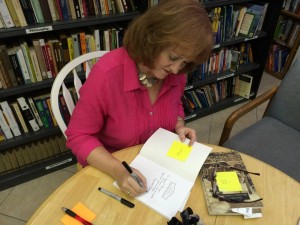
An immense “Thank You” to everyone who came out to Saturday’s book signing event at the Galveston Bookshop for “Galveston’s Broadway Cemeteries.”
I had such a great time meeting everyone and learning about their individual interests in history, cemeteries or personal connections with the cemeteries on Broadway. I hope to follow up with some of you to learn more!

